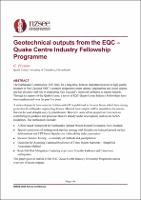Geotechnical outputs from the EQC – Quake Centre Industry Fellowship programme
Abstract
The Earthquake Commission (EQC) has, for a long time, been an important investor in high quality research in New Zealand. EQC’s research programme spans science, engineering and social science and has played a vital role in supporting New Zealand’s improved resilience to natural hazards. Through its support of the Quake Centre, a series of EQC-Quake Centre Industry Fellowships have been implemented over the past five years
A series of projects have come to fruition and will be published in the near future which have strong geotechnical earthquake engineering themes. Most of these outputs will be standalone documents that can be used straight away by practitioners. However, some of the projects are best seen as contributing to guidance and processes that are already under development such as the NZGS Guidelines. The publications include:
• A Risk Based Framework for Earthquake Ground Motion Hazard Estimation, New Zealand;
• Spatial correlations of underground pipeline damage with liquefaction-induced ground surface deformations and CPT-based liquefaction vulnerability index parameters
• Invasive Seismic Testing – a summary of methods and good practice
• Guideline for Assessing Technical Resilience of Three Waters Networks – Simplified Assessment Method
• Rock Fall Risk Mitigation: Capturing experience from the Kaikoura and Canterbury earthquakes
This paper gives an outline of the EQC-Quake Centre Industry Fellowship Programme and an overview of recent outputs.

